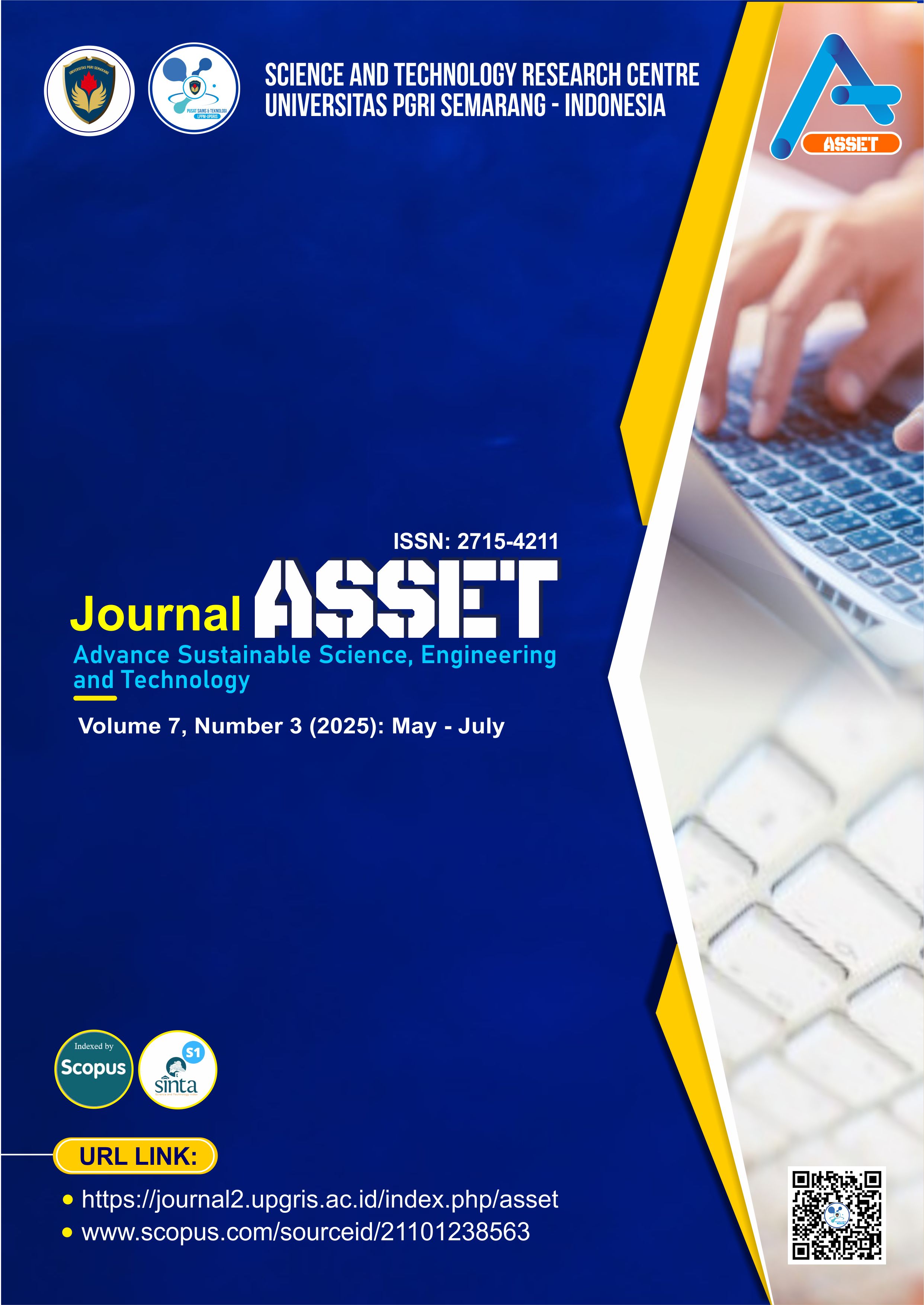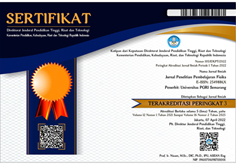Mechanical Properties of Epoxy Composite Reinforced with Spent Coffee Ground and Coffee Husk
DOI:
https://doi.org/10.26877/asset.v7i4.2052Keywords:
Coffee ground, coffee husk, mechanical properties, natural filler, sustainable compositesAbstract
This study aims to investigate the effect of increasing the concentration of natural filler on the mechanical properties of Spent Coffee Ground (SCG) / Coffee Husk (CH) reinforced epoxy matrix composite. The materials used in this study are epoxy resin as a matrix and waste coffee grounds and coffee husks as natural fillers with sizes of 100-mesh and concentrations of 10, 20, and 30 wt.%. The results showed that SCG 10 wt.% produced the best mechanical properties compared to the other samples based on tensile strength (19.58 MPa), tensile modulus (1.70 GPa), flexural strength (44.55 MPa), and flexural modulus (2.32 GPa). On the other hand, CH 30 wt.% contributed the highest hardness value of 50.33 HRB compared to other samples. The findings in this study prove that the appropriate composition will affect the compatibility between the filler and the matrix, thus impacting the mechanical properties of the composite. This phenomenon can be seen based on microscope analysis, which shows a strong interaction between the matrix and filler and the formation of voids and agglomeration
References
[1] N. Özmeral, M. Işık, M. Sogancioglu Kalem, and G. Ahmetli, “Lignocellulose coffee waste-based epoxy composites: effect of various treatment methods on composite properties,” Cellulose, vol. 30, no. 6, pp. 3589–3609, 2023.
[2] A. P. Irawan et al., “Elaeocarpus ganitrus (rudraksha) seeds as a potential sustainable reinforcement for polymer matrix composites,” Polymer Composites, 2024.
[3] C. Mishra, H. C. Baskey, C. R. Deo, D. K. Mohapatra, and P. Mishra, “Effect of wood dust filler on mechanical properties of polyester composite,” in Industry 4.0 with Modern Technology, CRC Press, 2024, pp. 285–289.
[4] T. Cionita et al., “The Influence of Filler Loading and Alkaline Treatment on the Mechanical Properties of Palm Kernel Cake Filler Reinforced Epoxy Composites,” Polymers, vol. 14, no. 15, p. 3063, 2022.
[5] Y. Leow, P. Y. M. Yew, P. L. Chee, X. J. Loh, and D. Kai, “Recycling of spent coffee grounds for useful extracts and green composites,” RSC advances, vol. 11, no. 5, pp. 2682–2692, 2021.
[6] K. Chawraba and S. A. El Mogy, “Rice Husk as Reinforcement in Wood Plastic Composites,” in Rice Husk Biomass: Processing, Properties and Applications, Springer, 2025, pp. 181–211.
[7] J. Yoo, S. J. Chang, S. Wi, and S. Kim, “Spent coffee grounds as supporting materials to produce bio-composite PCM with natural waxes,” Chemosphere, vol. 235, pp. 626–635, 2019.
[8] A. P. da Silva, M. de P. Pereira, F. R. Passador, and L. S. Montagna, “PLA/coffee grounds composites: A study of photodegradation and biodegradation in soil,” in Macromolecular Symposia, Wiley Online Library, 2020, p. 2000091.
[9] R. D. Bairwan, A. Khalil HPS, A. Nuryawan, M. I. Ahmad, M. H. M. Kassim, and A. Ahmad, “Enhancing biopolymer materials with coffee waste‐derived reinforcements,” Polymer Engineering & Science, vol. 65, no. 2, pp. 455–477, 2025.
[10] M. Marques, L. F. F. F. Gonçalves, C. I. Martins, M. Vale, and F. M. Duarte, “Effect of polymer type on the properties of polypropylene composites with high loads of spent coffee grounds,” Waste Management, vol. 154, pp. 232–244, 2022.
[11] E. Melyna and A. P. Afridana, “The effect of coffee husk waste addition with alkalisation treatment on the mechanical properties of polypropylene composites,” Equilibrium Journal of Chemical Engineering, vol. 7, no. 1, pp. 14–22, 2023.
[12] P. Tapangnoi, P. Sae-Oui, W. Naebpetch, and C. Siriwong, “Preparation of purified spent coffee ground and its reinforcement in natural rubber composite,” Arabian Journal of Chemistry, vol. 15, no. 7, p. 103917, 2022.
[13] W. Yang, W. Chang, J. Zhang, G. H. Yeoh, C. Boyer, and C. H. Wang, “Effects of waste coffee grounds on the mechanical properties, flame retardancy and toxic gas production of epoxy composites,” Materials & Design, vol. 224, p. 111347, 2022.
[14] M. Işık, N. Özmeral, G. Ahmetli, and M. S. Kalem, “Effect of various aging conditions and treatment methods on thermal degradation of coffee waste/epoxy composites,” Industrial Crops and Products, vol. 220, p. 119115, 2024.
[15] L. Songtipya, T. Limchu, S. Phuttharak, P. Songtipya, and E. Kalkornsurapranee, “Poly (lactic acid)-based composites incorporated with spent coffee ground and tea leave for food packaging application: A waste to wealth,” in IOP conference series: materials science and engineering, IOP Publishing, 2019, p. 12047.
[16] A. Kholil, S. T. Dwiyati, R. Wirawan, and ..., “Brake Pad Characteristics of Natural Fiber Composites from Coconut Fibre and Wood Powder,” Journal of Physics …, 2021, doi: 10.1088/1742-6596/2019/1/012068.
[17] “ASTM D638-14. Standard Test Method for Tensile Properties of Plastics. ASTM International.”
[18] “ASTM D790-15. Standard Test Methods for Flexural Properties of Unreinforced and Reinforced Plastics and Electrical Insulating Materials. ASTM International.”
[19] ASTM D785-03, “Standard Test Method for Rockwell Hardness of Plastics and Electrical Insulating Materials,” ASTM International, West Conshohocken, PA, 2015.
[20] N. Suaduang, S. Ross, G. M. Ross, S. Pratumshat, and S. Mahasaranon, “Effect of spent coffee grounds filler on the physical and mechanical properties of poly (lactic acid) bio-composite films,” Materials Today: Proceedings, vol. 17, pp. 2104–2110, 2019.
[21] C.-S. Wu, “Renewable resource-based green composites of surface-treated spent coffee grounds and polylactide: Characterisation and biodegradability,” Polymer Degradation and Stability, vol. 121, pp. 51–59, 2015.
[22] A. Nanni, M. Colonna, and M. Messori, “Fabrication and characterization of new eco-friendly composites obtained by the complete recycling of exhausted coffee capsules,” Composites Science and Technology, vol. 222, p. 109358, 2022.
[23] M. A. A. Majrashi et al., “Novel enhancement of interfacial interaction and properties in biodegradable polymer composites using green chemically treated spent coffee ground microfiller,” International Journal of Biological Macromolecules, vol. 266, p. 131333, 2024.
[24] B.-S. Baek, J.-W. Park, B.-H. Lee, and H.-J. Kim, “Development and application of green composites: using coffee ground and bamboo flour,” Journal of Polymers and the Environment, vol. 21, no. 3, pp. 702–709, 2013.
[25] J. Tellers, P. Willems, B. Tjeerdsma, N. Sbirrazzuoli, and N. Guigo, “Spent Coffee Grounds as Property Enhancing Filler in a Wholly Bio‐Based Epoxy Resin,” Macromolecular Materials and Engineering, vol. 306, no. 11, p. 2100323, 2021.
[26] L. Huang, B. Mu, X. Yi, S. Li, and Q. Wang, “Sustainable use of coffee husks for reinforcing polyethylene composites,” Journal of Polymers and the Environment, vol. 26, no. 1, pp. 48–58, 2018.
[27] T. Cionita et al., “The Influence of Hybrid Fillers on the Mechanical Properties of Woven Ramie-Reinforced Epoxy Composites,” in E3S Web of Conferences, EDP Sciences, 2024, p. 6006.
[28] E. Vengadesan, T. Arunkumar, S. Muralidharan, K. Debnath, H. Dutta, and K. Kadirgama, “Hybrid bio-composites reinforced with natural wood saw dust and eco-friendly graphite: evaluation of physical, mechanical, and thermal properties,” Fibers and Polymers, vol. 26, no. 2, pp. 833–854, 2025.
[29] T. Cionita et al., “Mechanical Characteristics of Biocomposites Based on Rice Husk Reinforced Recycled Polypropylene,” International Journal of Integrated Engineering, vol. 16, no. 2, pp. 278–287, 2024.
[30] K. S. Kumar, S. Gairola, and I. Singh, “Waste Coffee Silverskin as a potential filler in sustainable composites: Mechanical, thermal, and microstructural analysis,” Industrial Crops and Products, vol. 210, p. 118088, 2024.
[31] A. Hejna, M. Barczewski, P. Kosmela, and O. Mysiukiewicz, “Comparative analysis of the coffee and cocoa industry by-products on the performance of polyethylene-based composites,” Waste and Biomass Valorization, vol. 14, no. 8, pp. 2691–2706, 2023.
[32] D. García-García, A. Carbonell, M. D. Samper, D. García-Sanoguera, and R. Balart, “Green composites based on polypropylene matrix and hydrophobized spend coffee ground (SCG) powder,” Composites part B: engineering, vol. 78, pp. 256–265, 2015.
[33] N. Sienkiewicz, M. Dominic, and J. Parameswaranpillai, “Natural fillers as potential modifying agents for epoxy composition: A review,” Polymers, vol. 14, no. 2, p. 265, 2022.











